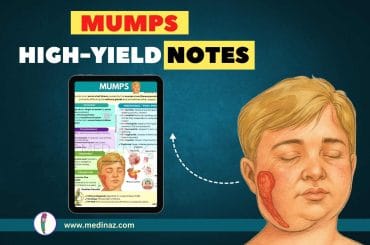Rocky Mountain Spotted Fever USMLE Notes & Mnemonics contains all the high-yield points you need to know.
- Rocky Mountain Spotted Fever: A severe tick-borne illness caused by Rickettsia rickettsii.
Epidemiology:
- Common in the southeastern and south-central United States.
- Peak incidence in spring and early summer.
Transmission:
- Transmitted by the bite of infected ticks (Dermacentor species). (Ref)
Pathophysiology:
- Rickettsia rickettsii infects endothelial cells → vasculitis.
Clinical Features:
- Incubation Period: 2-14 days post-tick bite.
- Early Symptoms: Fever, headache, malaise, myalgia.
- Rash: 2-5 days after fever onset; starts on wrists, ankles, then spreads to palms, soles, and trunk.
- Severe Cases: Can involve CNS, respiratory, gastrointestinal, and renal systems.
Diagnosis:
- Clinical Diagnosis: Based on symptoms, history of tick exposure, and characteristic rash.
- Serology: Indirect immunofluorescence assay (IFA) is the gold standard.
- PCR: For Rickettsia rickettsii DNA detection.
Treatment:
- Doxycycline: First-line treatment for all ages, including children.
- Start Treatment Immediately: If RMSF is suspected, without waiting for confirmation.
Complications:
- Severe Cases: Can lead to hospitalization, long-term health problems, or death.
- Potential Issues: DIC, multiorgan failure, limb gangrene necessitating amputation.
Prevention:
- Tick Avoidance: Protective clothing, tick repellents.
- Prompt Tick Removal: To reduce transmission risk.
Mnemonic: “RMSF – Really Mean Symptoms Fast”
- Rickettsia
- Mountains (Rocky Mountains, but more common in Southeast US)
- Spots (rash on wrists, ankles, palms, soles, trunk)
- Fever, headache, myalgia
Chart: RMSF Key Features and Management
| Feature | Description | Management Strategy |
|---|---|---|
| Rash | Wrist, ankles → palms, soles, trunk | Doxycycline |
| Fever | High fever within 2 weeks of tick bite | Immediate treatment initiation |
| Headache | Severe headache | |
| Complications | DIC, multiorgan failure | Hospitalization, supportive care |
| Prevention | Tick avoidance, prompt removal |
Note: On the USMLE, RMSF is often tested in the context of a patient with a history of tick exposure presenting with fever, headache, and a characteristic rash. Early recognition and prompt treatment initiation with Doxycycline is crucial, as delayed treatment can lead to severe complications.
Check other important USMLE Notes
A Visual Learning Platform





